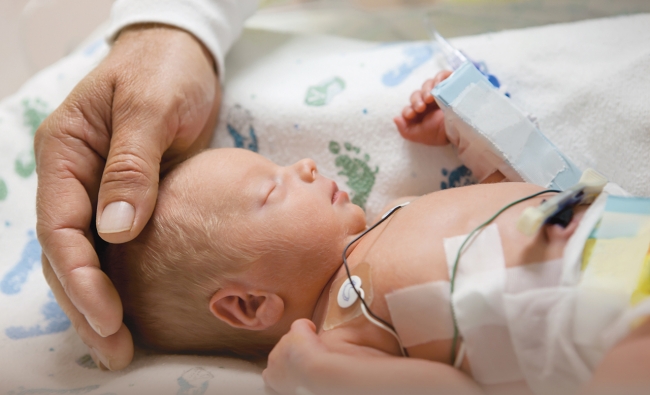Safety in Healthcare
B. Braun Cares About Safety
One of the biggest challenges facing health care providers today is enhancing safety and patient care while managing workflow efficiencies. B. Braun of Canada Ltd. is passionately committed to eliminating preventable treatment errors and enhancing patient, clinician and environmental safety with products, services and education focused on sharing best clinical practices.
Safety For
Patient Safety
As a division of the 14th largest global medical device manufacturer, B. Braun is uniquely positioned to address some of the most pressing issues facing healthcare today. Guided by our Sharing Expertise® philosophy, B. Braun leads the way in developing infusion therapy and pain management products and services that meet the highest standards for quality, safety, sustainability and efficiency.
Our Commitment to the Use of Safe Materials
More than 40 years ago, B. Braun recognized the environmental and patient risks posed by medical products containing PVC and DEHP. We were the first medical device manufacturer to remove these harmful substances from many of our products, and remain the only supplier offering a full line of IV drug and solution containers not made from PVC or DEHP.
Reducing Patient Exposure to Toxic Chemicals
A growing body of evidence shows that North Americans receiving care in hospitals and other settings can be overly exposed to dangerous levels of phthalates, a family of toxic chemicals. Diethylhexyl phthalate (DEHP), which is used to soften polyvinyl chloride (PVC), is the phthalate most commonly used in medical products.1
Some medical products such as IV bags and tubing can contain up to 40% DEHP by weight, resulting in significant levels of exposure for neonates and other vulnerable patient populations.2
The American Medical Association, among other professional organizations, encourages hospitals and physicians to reduce and phase out the use of PVC medical device products, especially those containing DEHP.3
Who is at Risk?
Products not made with PVC or DEHP help protect susceptible populations: male neonates, pregnant and lactating women, pediatric patients, and chemotherapy patients.
Male Neonates
Pregnant and Lactating Women
Pediatric Patients
Chemotherapy Patients
Healthcare Professional Safety
Hazardous drug exposure and needlestick injuries continue to be major areas of concern for healthcare workers throughout Canada. B. Braun is committed to addressing these issues by providing a robust portfolio of safety-engineered products that are designed to offer healthcare workers protection against hazardous drugs, infection and blood-borne pathogens in the workplace. Through our product portfolio and educational initiatives, B. Braun is leading the effort to address these issues head-on.
Environmental Safety
At B. Braun, going green is not a new trend but a core value we’ve embraced throughout our history. In fact, B. Braun leads in the research and development of green manufacturing processes in the U.S. and around the world. Our two key manufacturing facilities in the U.S. are 100% landfill-free and we are constantly striving to reduce our environmental footprint across the organization.
References
1 Schettler, T. Polyvinyl chloride in health care. Health Care Without Harm. January 2020.
2 Karpf, A. MD. Making patient safety a policy priority. Modern Healthcare. February 2021.
3 American Medical Association. (2016). Encouraging Alternatives to PVC/DEHP Products in Health H-135.945.
4 Vinyl chloride: what is vinyl chloride? National Cancer Institute. Reviewed December 28, 2018. Accessed November 12, 2021. https://www.cancer.gov/about-cancer/causes-prevention/risk/substances/vinyl-chloride
5 Public health statement: Vinyl Chloride. Agency for Toxic Substances and Disease Registry. July 2006. Accessed November 12, 2021. https://www.atsdr.cdc.gov/toxprofiles/tp20-c1-b.pdf
6 Polyvinyl chloride and copolymers production: national emission standards for hazardous air pollutants (NESHAP) – 40 CFR 63 subparts J & H. U.S Environmental Protection Agency. Updated February 23, 2021. Accessed November 12, 2021. https://www.epa.gov/stationary-sources-air-pollution/polyvinyl-chloride-and-copolymers-production-national-emission-0.
7 NTP-CERHR Monograph on the Potential Human Reproductive and Developmental Effects of Di(2-Ethylhexyl) Phthalate (DEHP), National Toxicology Program, Department of Health and Human Services, Retrieved at: https://ntp.niehs.nih.gov/ntp/ohat/phthalates/dehp/dehp-monograph.pdf
8 US Consumer Product Safety Commission (CPSC) to Expand Phthalates Restriction under CPSIA. October 25, 2017. AccessedDecember 17, 2021. https://www.sgs.com/en/news/2017/10/safeguards-16217-us-cpsc-to-expand-phthalates-restriction-under-cpsia
9 OEHHA Science for Health California. Proposition 65 Warnings Office of Environmental Health Hazard Assessment: Di(2-ethylhexyl)phthalate (DEHP). June, 2017. https://www.p65warnings.ca.gov/fact-sheets/di2-ethylhexylphthalate-dehp
10 FDA CEDRH. Safety Assessment of Di(2-ethylhexly) Phthalate (DEHP) Released from PVC Medical Devices. FDA CEDRH 1 – 118, 2003.
11 EB Mallow and MA Fox. (2014). Phthalates and critically ill neonates: device-related exposures and non-endocrine toxic risks. Journal of Perinatology, 1-6.
12 Sharpe RM, Skakkebaek NE (2008) Testicular dysgenesis syndrome: mechanistic insights and potential new downstream effects. Fertil Steril 2008; 89(2 Suppl):e33-e38.
13 US Consumer Product Safety Commission (CPSC Prohibition of Children’s Toys and Child Care Articles Containing Specific Phthalates. October 27, 2017. Accessed December 17, 2021.
14 Desdoits-Lethimonier C, Albert O, Le Bizec B, Perdu E, Zalko D, Courant F, Lesné L, Guillé F, Dejucq-Rainsford N, Jégou B (3/2012) Human testis steroidogenesis is inhibited by phthalates. Hum Reprod; 2012 Mar 8. [Epub ahead of print]
15 Dodson RE, Nishioka M, Standley LJ, Perovich LJ, Brody JG, Rudel RA Endocrine Disruptors and Asthma-Associated Chemicals in Consumer Products Online 8 March 2012
16 Hannas BR, Furr J, Lambright CS, Wilson VS, Foster PM, Gray LE (2011) Dipentyl phthalate dosing during sexual differentiation disrupts fetal testis function and postnatal development of the male Sprague-Dawley rat with greater relative potency than other phthalates. Toxicol Sci 120(1):184-193.
17 Maas, B., Huber, C. & Krämer, I. Plasticizer extraction of Taxol®-infusion solution from various infusion devices. Pharm World Sci 18, 78–82 (1996). https://doi.org/10.1007/BF00579710









